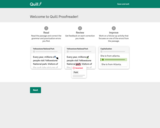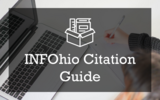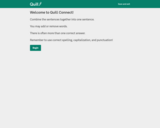
Students correct a variety errors within a text. The errors are underlined.
- Subject:
- English Language Arts
- Language, Grammar, and Vocabulary
- Writing
- Material Type:
- Activity/Lab
- Assessment
- Interactive
- Provider:
- Quill
- Date Added:
- 03/16/2021

Students correct a variety errors within a text. The errors are underlined.

Students add however, therefore, consequently, and for example to the middle of a sentence to connect the idea to the sentence before it. Students choose which joining word to use.

Students practice using however or therefore. Students must choose the joining word that best connects the ideas and then add it to the beginning of the correct sentence.

Students practice using however to connect two ideas. Students must decide which sentence goes first and add however to the beginning of the second sentence to show a relationship of contrast.

Research article on the use of book trailers to promote reading in the classroom. The article discusses the benefits of book trailers, provides examples of effective book trailers, and offers tips for creating book trailers that engage students.

Students find and correct past participle errors within a text

A lesson plan for using the BookNook platform to create book trailers. The lesson includes step-by-step instructions for creating a book trailer and offers tips for making the trailer engaging and effective.

The INFOhio Citation Guide includes a variety of websites, tutorials, documents, and videos for grades 6-12 to support students as they cite sources and provide attribution for resources and images used during the research process.

Students correct a variety errors within a text. The errors are underlined.

Students correct a variety errors within a text. The errors are underlined.

This content pack is intended to be a way for educators to discover new resources and lessons for teaching information literacy skills in grades 6-12. The instructional materials contained within this pack were selected to support students as they grow and develop the following skills. Develop a topic for research. Explain research goals. Formulate essential questions and questions to guide research. Reflect on prior knowledge.

This is a research article on the use of book trailers to promote reading in schools. The article discusses the benefits of book trailers, provides examples of effective book trailers, and offers tips for creating book trailers that engage readers.

Students correct a variety errors within a text. The errors are underlined.

Building the Future of Arts Education
Professional development for educators. Summer intensives for young artists. Teaching artist-guided activities for families. Performances for young audiences. Classroom lesson plans. Arts-focused digital media.
Kennedy Center Education offers a wide array of resources and experiences that inspire, excite, and empower students and young artists, plus the tools and connections to help educators incorporate the arts into classrooms of all types.

Students use the method of their choice to combine two sentences based on the short story, "Lamb to the Slaughter" by Roald Dahl. Students practice using various types of phrases and clauses to convey meaning and add variety to combined sentences.

Students learn to write with parallel structure so that actions in a list are in the same form. This is the only lesson in the parallel structure lesson pack.

Students learn to combine sentences using a descriptive phrase at the beginning of a sentence that begins with an -ing, -ed, or -en word. This is the lesson 1 of 2 in the participial phrases lesson series.

Students apply what they learned in Lesson 1: Participial Phrases by writing a paragraph that contains three sentences that begin with a participial phrase. This is lesson 2 of 2 in the participial phrases lesson series.

Students apply what they learned in Lesson 1: Compound Objects and Predicates and Lesson 2: Compound Subjects by writing a paragraph that includes a compound subject, a compound object, and a compound predicate. This is lesson 3 of 3 in the compound subjects, objects, and predicates lesson series.

Students apply what they learned in the complex sentences lessons 1-3 by writing a paragraph that includes four complex sentences. This is lesson 4 of 4 in the complex sentences lesson series.